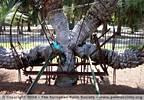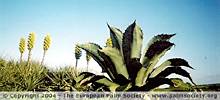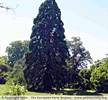 Letters
Letters
 
Butia Capitata in Panama City. This rare four-headed palm is the only one of its kind known in the world.
Photos by Richard Ferrick
Panama City Butia
I ran across your website and I would like to share a picture of a Butia capitata we have in our city. I'm the
network administrator for the City of Panama City, Florida, USA. We have a palm that started growing at our
water treatment facility and as you can see from the picture, it's the most unique palm you will ever see. The
picture shows the palm after our city officials decided to move it. We added a metal frame to help support the
palm. I plan to have it on our website soon. www.cityofpanamacity.com
The plaque on the fence around the palm reads: Butia Capitata - Pindo Palm. This rare four-headed palm, the
only one of its kind known in the world, is dedicated to the people of Panama City. It was relocated from the
City’s water treatment facility on May 3, 1997. This was made possible by: City of Panama City/Dept. Leisure
Services, International Palm Society (Gulf Coast Chapter), Robert Reinheimer (coordinator/harvester), Deep South
Crane, Kurt Schmidt (fabricator), City of Panama City Utility Dept., Panama City Rentals.
Thanks, Richard Ferrick

 
Left: Palm seeds being boiled and crushed in a hollowed-out tree trunk to release the oil. Ngang, Cameroon.
Right: Anthony gearing up to climb an Oil Palm for tapping its flower stalks. The hollowed gourd is used to
catch the sugary sap.
Photos by Vic Silver
Cameroon
I have just received the latest copy (47) of Chamaerops plus two back issues, which which for a new palm enthusiast
and member of the EPS were a pretty exciting arrival, I certainly now do not feel alone in my new found obsession
for palms and other exotic plants. I started about 2 years ago by purchasing a couple of Trachycarpus.fortunei
as they seem to be the only ones apart from Cordyline that are readily available. On a trip to the Algarve I
managed to get through customs a very small Washingtonia filifera, maybe 1 year old, which I kept inside until
about April as I wasn’t sure of it’s cold hardiness. It is now doing very well. The coldest spell
last winter was down to — 6°C. Do you think it would have survived this low?
I have also just got back from a visit to the Cameroon where a friend of mine is working. There were lots of
palms growing in Cameroon, most of which were the African Oil palms. They were everywhere, some over 80 years
old and looked to be about 80 or 90 feet tall!. Local people are tapping them for wine. I tasted the palm wine
straight from the palm, it was OK, tasted a bit like unfermented homemade wine, very cloudy and a bit yeasty.
These palms seemed to be the main source of income here for many of the tribes in the north west of the country,
as they produce fruit for most of the year.
I was actually staying in the north west of the country for the majority of my stay which is at quite high altitude,
but if you head south, down to the lowlands, it gets extremely hot and humid. The most common palm is the Coconut
palm, which seems best suited to the humid environment. I stayed a couple of nights in the south and some of
the palms I spotted there included Roystonea. I actually paid a visit to the botanical gardens in Limbe. Here
they had an excellent collection of exotic plants and palms. Another Palm encountered in Cameroon was a Rattan
palm, locally referred to as Raffia cane and used for making chairs, fences, buildings etc. This grew mainly
in the north.
Thanks, Vic Silver vic.s@breathe.com
Dear Vic,
Your Washingtonia may have survived the —6°C but it was probably a good idea to keep it inside over
the winter. With increasing age, their cold hardiness improves dramatically. A mature tree can survive -8 to
-10°C with little or no damage, and dry frosts to -12°C or even lower. Plants can survive much lower
temperatures but usually lose all their leaves. Hardiness in Washingtonia depends a lot on humidity and plants
benefit greatly from a rain protection in winter.
By the way, it is perfectly legal to bring palms from Spain. Within the European Union there are no restrictions
anymore for any plants for personal use and only few restrictions for the nursery trade.
T.S.

Letter from Hawaii
The reason I write this is to alert you to what is happening here in Hawaii, in regard to some people’s
fears of alien plant species. The landscape and nursery industry has been targeted as the cause of 80% of invasive
plant species putting our native species at risk.
Each of the Hawaiian Islands now has an invasive species committee with an umbrella group statewide. They are
bringing up many valid concerns and are VERY well organized. They are promoting something called the New Zealand
model which is a 50 point rating system to determine which species they label as pests not to be planted or
sold. Fortunately, the LICH (Landscape Industry of Hawaii) has taken the bull by the horns and are attempting
to be self-regulated rather than have these committees get bills passed that would be very severe and detrimental
to the Agricultural Industry as a whole.
I am in full support of the efforts to protect our native species, but was quite concerned that Washingtonia
robusta, W. filifera, coffee, guava, allspice and numerous others have already been identified as pest species.
The same criteria used on many other palms like the genera Pinanga, Ptychosperma, Archontophoenix, Phoenix,
Dypsis, Livistona, Arenga, Chamaedorea, Roystonea, Sabal and Nypa might label these as pests as well. In fact,
almost any other palm capable of reseeding itself could have this designation applied. This alone would be unfortunate,
but to make matters more serious, we have at least one nursery threatened with a fine because they had coqui
tree frogs on their grounds and are required to eradicate the frogs as an alien species. The same mind set could
force nurseries and landscapers to discontinue using any palms labelled as pests. Incidentally, several macadamia
nut growers around the nursery believe the tree frogs have actually increased their profits by reducing nut
boring insects (which are also not native).
I am happy to see our islands protected from unwanted pests, but I feel it is important for the Palm Society
to be aware of what is going on. If we are proactive and have input in the process, we hopefully can avoid throwing
out the baby with the bathwater.
Norman Bezona, Hawaii


A bank at the end of the approach to the beach in Falmouth with Puyas and Agaves.
Photo by Rev. Geoffrey Squire
Southwest Towns and Cities
Dear Mr. Spanner, how right you are in your Editorial of the No.47 edition of Chamaerops about the much wider
availability of palms. When I first began searching for palms and other exotics from the early 70s, I found
it extremely difficult to obtain anything of interest. Occasionally I saw Cordyline australis, but tracking
down Trachycarpus fortunei was so difficult that I grew some from seed picked up in a Cornish churchyard. Phoenix
canariensis, likewise, took me years to find, and that in our own county of Devon and nearby Cornwall, by far
the most mild and 'palmy' regions of Britain. Now things are very different. Cordyline are sold everywhere,
from supermarkets to roadside petrol stations. Someone at a local garden centre told me that they have sold
thousands of Phoenix canariensis over the past few years. Trachycarpus, Chamaerops, Butia, other palms, and
things like bananas and Dicksonia are less freely available but are now to be found in all good garden centres
in Southwest England.
The sad thing is that all the 'palmy things' seem to be going in to private gardens. The parks and gardens departments
of our Southwest towns and cities seem to have great reservations about planting anything exotic. The problem
seems to be that the one who takes the responsibility for the decision making as to what goes in the gardens
dreads having to answer to the council if the coldest winter on record should follow and something should die.
The fact that huge specimens of palms that are many years old may grow in adjacent private gardens does not
seem to be taken into account.
There are, however, two exceptions: Torquay in Devon, where they are beginning to plant small numbers of a variety
of palms; and Falmouth in Cornwall, which must be the most adventurous 'palmy' town in Britain. The enclosed
photographs gives just two examples: the large roundabout at the main approach to Falmouth, and the bank at
the end of the approach to the beach with its Puyas and Agaves. Just inland is the Fox Rosehill Garden with
numerous varieties of palms and other exotics, including a huge flowering tree of Datura. Palm enthusiasts should
just walk along the sea front and the adjacent streets and look into the gardens to see Phoenix and other exotics
in considerable numbers and in first class condition. In one place not far away, Phormium, Cordyline, and Geranium
maderensis have naturalised on the cliffs and I have been told that a Chamaerops is growing in one inaccessible
place.
Yours sincerely,
Rev. Geoffrey Squire, Little Cross, Northleigh Hill, Goodleigh, Barnstaple, Devon EX32 7NR, U.K.

 
 
Form left to right:
Trachycarpus fortunei outside in Paris.
Two old Araucaria araucana.
Landscaping with Trachys and Yuccas at Euro-Disney.
A Giant Redwood in Paris, impossible in Dallas.
Photos by Tony Cerbone
USDA Zone 8 vs. USDA Zone 8. It’s Not the Same!
It is hard to believe that Dallas and Paris are both USDA zone 8. Paris is at 48° northern latitude and
Dallas is at 32° latitude, the same as Casablanca, Morocco. They both have about the same average winter
minimum low temperature, between 20 and 10°F (-7 and -12°C), and while they share many exotic looking
plants that can grow in both climates, the long cool winters in Paris allow other exotics to thrive there that
would wither in Dallas’ summer heat. Likewise many heat loving plants grow exuberantly in Dallas while
languishing in Paris.
I was in Paris Disneyland recently and the landscape designers used many of the plants that I use in Dallas
to create a tropical looking effect. The plants used both in Paris and Dallas are: Trachycarpus fortunei, Fatsia
japonica, Persian Ivy, Catalpa, Golden Bamboo, Black Bamboo, Loquat, Mimosa, Yucca recurvifolia and Brugmansia.
Exotic plants that do well in Paris but not Dallas are for instance Sequoia gigantean, which is everywhere,
the Monkey Puzzle Tree (Araucaria) and Cordyline australis.
Ones that do better in Dallas than in Paris are Live Oaks, Lantana, Crepe Myrtle (but they do live and flower
in Paris too, just not used much), Chamaerops humilis (it lives but doesn’t look good and isn’t used
much), Sabals, Washingtonia and the large Japanese timber bamboos. Many tropical flowers are common in US South.
Most tropical looking plants do better with warmer weather, so our favorite exotics look better in Dallas and
grow faster than in Paris.
The cooler climate of Paris allows for other exotics to be grown that prefer the cooler summers. Monkey Puzzles
and Sequoias look spectacular here. Also temperate trees like cherries, and plums are lush and dense here with
heavy bloom each spring. Many zone 7 plants thrive in Paris like Paper birch, blue spruce and liliac. These
are plants that are almost impossible to grow in Dallas. Both cities are classified as USDA zone 8 but with
strong differences. I’ve tried to only mention plants that I’ve seen in large quantities in a variety
of locations. Not just protected microclimate sites. I thought you might enjoy my observations.
Tony Cerbone, Dallas, Texas, U.S.A. TonyDFW@prodigy.net

Palm Ailments
I am a member of the Palm Society and look forward to each and every edition of Chamaerops. I am a keen amateur,
but not very knowledgeable when it comes to identifying certain ailments that cause these magnificent trees
to die. The books by David Jones and Martin Gibbons are of great help, but the information contained in these
books has not helped me to identify the causes of diseases and, subsequently, I have lost a number of Cordyline
and palm trees.
I am wondering if in future editions of Chamaerops it would be possible to provide pictures and articles that
show certain ailments and advice on how to correct these ailments. For example, I have Cordylines that have
yellow spotting on their strap-like leaves and, on the red version, green spotting. I have tried high nitrogen
feeds but to no avail. I also have a Phoenix canariensis that gets rot halfway up its fronds and none of the
books are able to identify what causes this. I feel it would be of great benefit to people like myself to be
able to identify and then correct ailments in order to keep the plants looking healthy. Keep up the good work.
Yours Sincerely,
Michael O’Brien, 206, The Roundabout, Northfield, Birmingham B31 2UA, U.K.
Dear Michael,
We will try to identify the problems of you palms if you send in some photographs. The EPS Internet Forum is
also a great place to get help from other enthusiasts. If you want to get seriously involved with identifying
palm diseases, I can highly recommend the following book (also available in the EPS online bookstore):
Broschat, T. K. & A. W. Meerow. 2000. Ornamental Palm Horticulture. University Press of Florida. ISBN 0-8130-1804-8
T.S.

|
 |
[an error occurred while processing the directive] |
